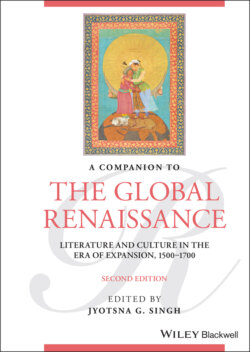Читать книгу A Companion to the Global Renaissance - Группа авторов - Страница 22
Afterword
ОглавлениеFollowing the four parts, Ayesha Ramachandran’s “Afterword: Lyric Poetics for the Global Renaissance” moves beyond familiar expectations for an afterword, which typically call for a reflection on the contents of the volume. Instead, it seeks to expand our understanding of an “emerging global imaginary” by calling for a “more substantive consideration of lyric poetry” within the critical methodological paradigm of the “Global Renaissance.” This configuration, she suggestively proposes, can “usefully expand and deepen studies of both the lyric and the early modern experience of globality.” Here the term “lyric” is not simply used as a formal generic designation. For Ramachandran, it is a “philosophic and anthropological mode to signal the vast array of shortish poems … that call attention to the person of a human individual,” making “a philosophic claim for the significance of the particular” – as for example, of the “first-person address.” The many products of “early modern engagement” in the chapters of this volume include visual and material objects as well epic poems, travel narratives, and in one instance, lyric poems. However, the Afterword’s call, as I see it, is to reflect on further possibilities – to follow lyric circulations around the world, attending to affective economies of exchange and interaction among individuals. More importantly, Ramachandran’s call to “lyric thinking” as an “alternate means of exploring and expressing the global” offers us a lens and a methodology (as I explore in the Preface) through which to consider lyrical elements – lyric thinking – within narratives, discourses, and artifacts of a global early modernity. What did it mean for individuals in the Renaissance to inhabit a shifting, expanding world of globalization, travel, and cross-cultural encounters? How can we uncover glimpses of individual viewpoints, experiences, voices? “Lyric thinking” entails a focus on phenomenology and process, rather than on ideological fixities. Thus, I hope that as readers, the “Afterword” nudges us to reappraise the experiential – the “phenomenology of worldly experience” – that can be drawn out from individual chapters, by attending to different perspectives and voices, and to reflect on “which voices get heard and how they get heard.”
